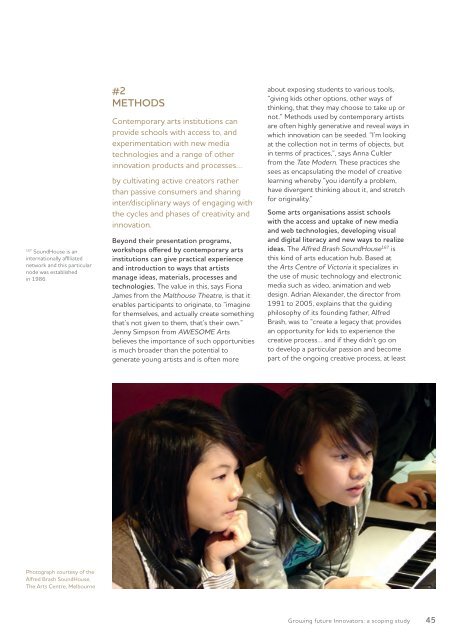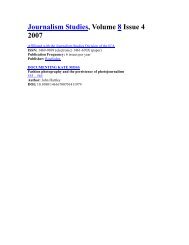GrowinG Future innovators - ARC Centre of Excellence for Creative ...
GrowinG Future innovators - ARC Centre of Excellence for Creative ...
GrowinG Future innovators - ARC Centre of Excellence for Creative ...
Create successful ePaper yourself
Turn your PDF publications into a flip-book with our unique Google optimized e-Paper software.
167 SoundHouse is an<br />
internationally affiliated<br />
network and this particular<br />
node was established<br />
in 1986.<br />
Photograph courtesy <strong>of</strong> the<br />
Alfred Brash SoundHouse,<br />
The Arts <strong>Centre</strong>, Melbourne<br />
#2<br />
METHODS<br />
Contemporary arts institutions can<br />
provide schools with access to, and<br />
experimentation with new media<br />
technologies and a range <strong>of</strong> other<br />
innovation products and processes…<br />
by cultivating active creators rather<br />
than passive consumers and sharing<br />
inter/disciplinary ways <strong>of</strong> engaging with<br />
the cycles and phases <strong>of</strong> creativity and<br />
innovation.<br />
Beyond their presentation programs,<br />
workshops <strong>of</strong>fered by contemporary arts<br />
institutions can give practical experience<br />
and introduction to ways that artists<br />
manage ideas, materials, processes and<br />
technologies. The value in this, says Fiona<br />
James from the Malthouse Theatre, is that it<br />
enables participants to originate, to “imagine<br />
<strong>for</strong> themselves, and actually create something<br />
that’s not given to them, that’s their own.”<br />
Jenny Simpson from AWESOME Arts<br />
believes the importance <strong>of</strong> such opportunities<br />
is much broader than the potential to<br />
generate young artists and is <strong>of</strong>ten more<br />
about exposing students to various tools,<br />
“giving kids other options, other ways <strong>of</strong><br />
thinking, that they may choose to take up or<br />
not.” Methods used by contemporary artists<br />
are <strong>of</strong>ten highly generative and reveal ways in<br />
which innovation can be seeded. “I’m looking<br />
at the collection not in terms <strong>of</strong> objects, but<br />
in terms <strong>of</strong> practices,”, says Anna Cultler<br />
from the Tate Modern. These practices she<br />
sees as encapsulating the model <strong>of</strong> creative<br />
learning whereby “you identify a problem,<br />
have divergent thinking about it, and stretch<br />
<strong>for</strong> originality.”<br />
Some arts organisations assist schools<br />
with the access and uptake <strong>of</strong> new media<br />
and web technologies, developing visual<br />
and digital literacy and new ways to realize<br />
ideas. The Alfred Brash SoundHouse 167 is<br />
this kind <strong>of</strong> arts education hub. Based at<br />
the Arts <strong>Centre</strong> <strong>of</strong> Victoria it specializes in<br />
the use <strong>of</strong> music technology and electronic<br />
media such as video, animation and web<br />
design. Adrian Alexander, the director from<br />
1991 to 2005, explains that the guiding<br />
philosophy <strong>of</strong> its founding father, Alfred<br />
Brash, was to “create a legacy that provides<br />
an opportunity <strong>for</strong> kids to experience the<br />
creative process… and if they didn’t go on<br />
to develop a particular passion and become<br />
part <strong>of</strong> the ongoing creative process, at least<br />
Growing future Innovators: a scoping study 45




![Plebiscite (Riegert chapter) revised FINAL [Feb 14].pdf](https://img.yumpu.com/8710373/1/190x245/plebiscite-riegert-chapter-revised-final-feb-14pdf.jpg?quality=85)